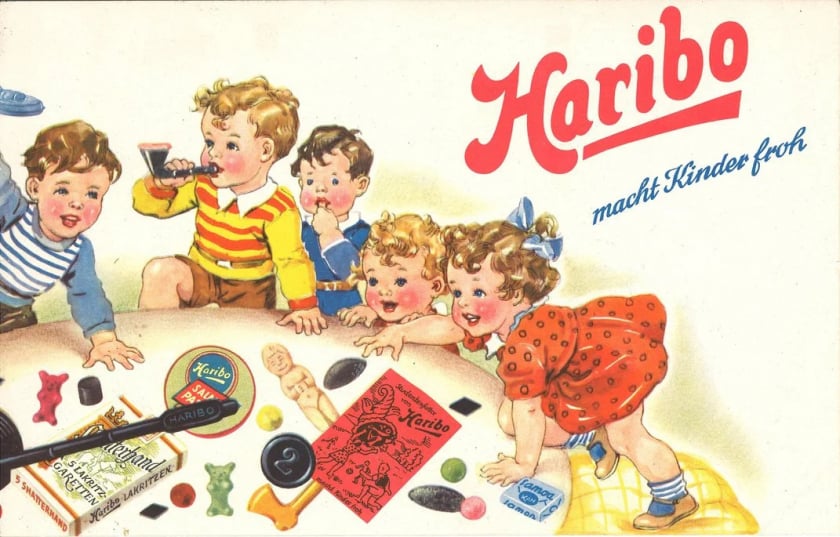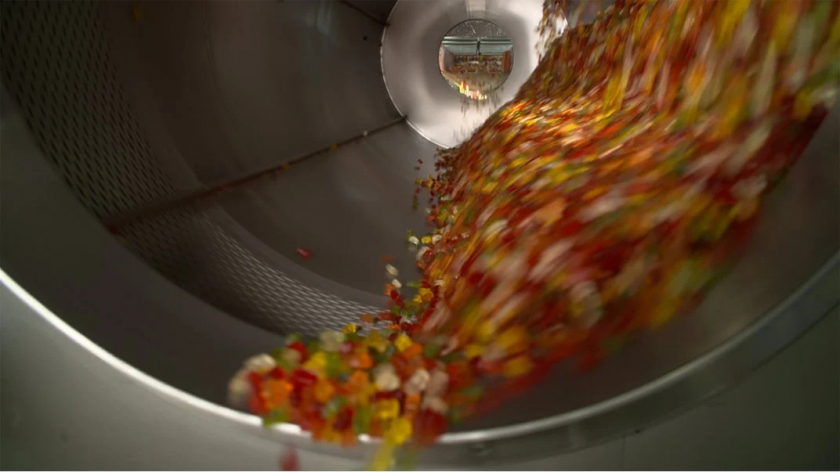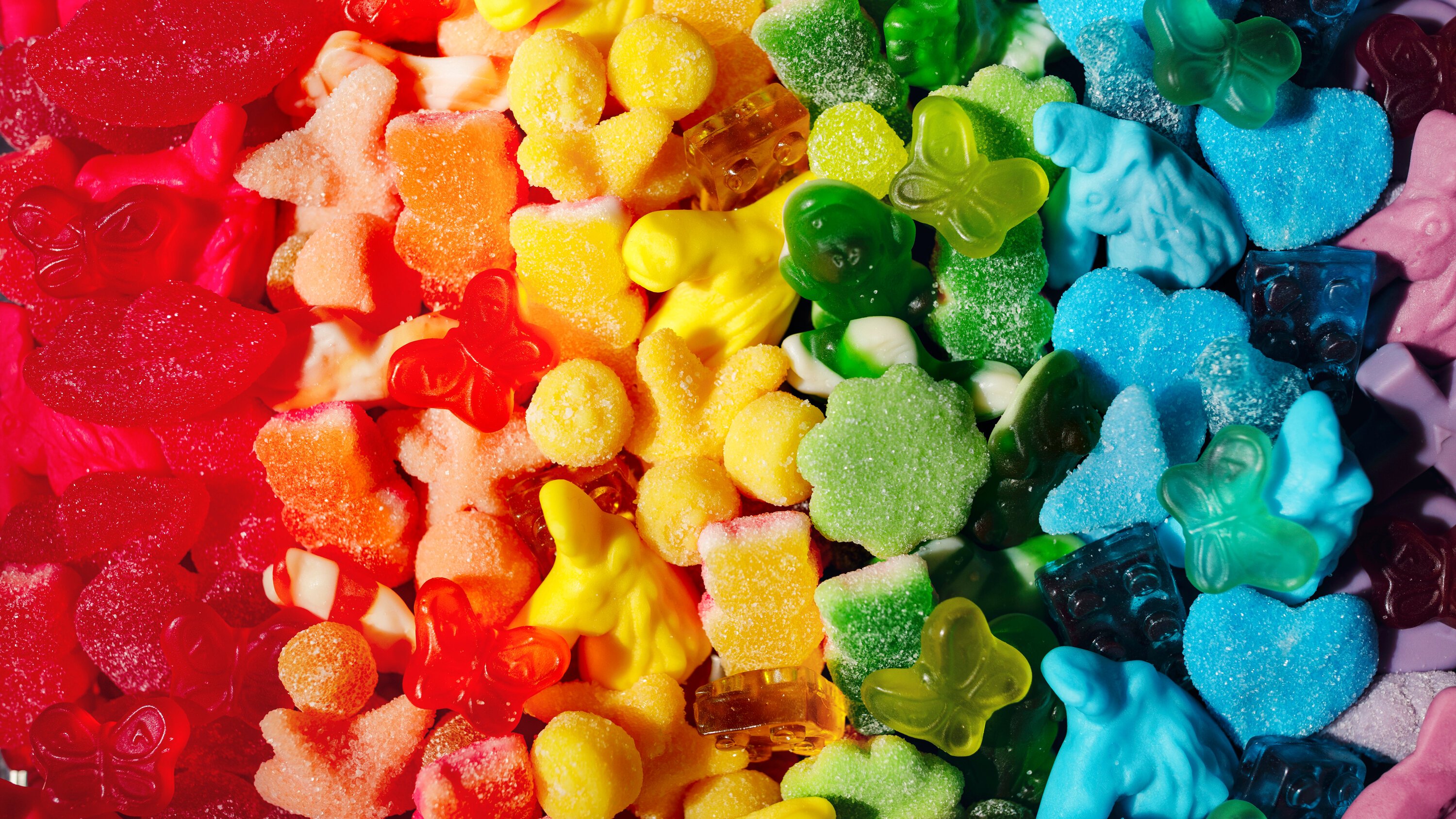Marshmallows are a childhood snack that many young people know. Colorful marshmallows in the shape of animals are made from a mixture of sugar and syrup. The sweet taste of this dish has captivated generations of students, and even adults love it. Moreover, this candy is also suitable for vegetarians or those who follow the dietary rules of some religions.
Germany is the country where the first gummy bears were born. Here, the candy is called Gummibär or Gummibärchen. The first gummy bears were produced in 1920 by a manufacturer from Bonn (Germany), Hans Riegel Sr. (Haribo company).

The first packaging of Haribo candy brand.
The first batches of candy
In 1920, Hans Riegel Sr., a German confectioner, founded Haribo, an acronym derived from his first name and hometown (Bonn). In a small kitchen with a few copper pots, a pin, and a stove, the first experimental batches of candy were made.
A year later, Hans hired his first employee, his wife Gertrud. Her job was to bike around the city delivering and marketing the new product to customers. Hans worked hard in the small kitchen preparing a brand new sweet: gummy bears.
"We've all heard the story of Apple starting in a small garage. Gummy bears started in a similar way. Riegel wanted to make a difference with little capital and almost no opportunity to make money," said Christian Bahlmann, Vice President of Corporate Communications at Haribo.

Gummy bears are still used today.
The original flavor of the gummy candy
Although Riegel was the first to create gummy bears, the history of gelatin-based candies predates his invention. According to Beth Kimmerle, author of four books on the American confectionery industry, gummy bears are the precursors to chewing gum, Turkish Delight, and gin gum (a British hangover cure).
"I think the real precursors to gummies were jams or jellies, which were preserves of cooked fruit with pectin or starch. Japan was the birthplace of fruit jellies like that," says Kimmerle.
Susan Benjamin, a candy historian, author, and owner of True Treats Historic Candy in Harpers Ferry, West Virginia, said the earlier candies had “pre-set” recipes. Later, Riegel simply tweaked them and added the cute bear shape.
Riegel wasn't the only candy entrepreneur active in the early 1920s. American Fred W. Amend created Chuckles, a sugar-coated jelly candy, while German immigrant Henry Heide created Jujubes and Jujyfruits.
But Riegel made his mark with his business acumen, embracing new advances in flavoring and coloring “because he understood that candy is all about form and texture,” Kimmerle says. “He took the latest color technology and the latest flavorings and applied them to his gummy bears.”

Marshmallows come in many different shapes and colors.
The evolution of gummy bears
During the 1930s, Riegel's company grew to 400 employees and introduced new gummy candies. The gummy bear inventor coined the slogan for his company: "Haribo makes children happy."
After its peak in the 1930s, World War II brought his company to a standstill. Riegel himself died in 1945 at the age of 52, leaving his wife, Gertrud, in charge of running the company. The couple's sons took over leadership of Haribo the following year, with Paul overseeing production and Hans Jr. managing marketing and sales.
“They almost had to shut down production, so they really started from scratch after the war ended,” Bahlmann said.
By 1950, the Rigel brothers had turned their father's estate into a giant candy factory. The number of employees had increased from 30 to 1,000. As Haribo continued to grow in the 1950s and 1960s, executives took advantage of television as one of the most modern marketing tools of the time.
“It was one of the first brands in Germany to do TV advertising, which really made Haribo famous,” Bahlmann shares.

Quality consistency makes gummy candy successful
Key to Haribo’s success is the consistency and quality of its products and its marketing. Another strength is that Haribo’s legacy continues to expand and is owned by the Riegel family, now in its third generation of candy makers. Paul died in 2009, while Hans Jr. died in 2013, leaving his grandson Hans-Guido to run the company.
On the other hand, Bahlmann believes that the company’s long-term success is the childhood memories that are preserved in each gummy bear. Haribo has many product lines and they are also distributed in countries with different cultures. But, the excitement and nostalgia of tasting the sweet candy and taking us back to our childhood are the values that customers all over the world appreciate.



































